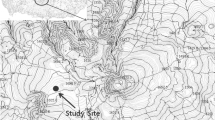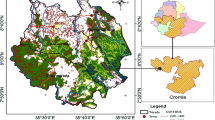Abstract
The organic carbon storage in trees and organic carbon flow with geoposition of trees was estimated in the forest area of Chittagong (South) Forest Division within geo-position 91°47′ and 92°15′ East longitude and 21°45′ and 22°30′ North latitude. The study was conducted through stratified random sampling by identifying each sampling point through Global Positioning System (GPS). It was found that above ground organic carbon storage (t/hm2), below ground organic carbon (t/hm2) and total biomass organic carbon (t/hm2) was respectively the highest in Dipterocarpus turbinatus (Garjan) (7.9, 1.18 and 9.08 t/hm2) followed by Tectona grandis (Teak) (5.66, 0.85 and 6.51 t/hm2), Artocarpus chaplasha (Chapalish) (2.32, 0.34 and 2.66 t/hm2), Artocarpus lacucha (Batta) (1.97, 0.29 and 2.26 t/hm2) and Artocarpus heterophyllus (Jackfruit) (1.7, 0.25 and 2.26 t/hm2). From the study it was revealed that organic carbon stock was the highest (142.7 t/hm2) in the geo-position 22° Latitude and 92° Longitude and was the lowest (4.42 t/hm2) in the geo-position 21° 50′ Latitude and 92° 2.5′ Longitude. The forest of the study area is a good reservoir of organic carbon so has a good capacity to sequester organic carbon from the atmosphere. Sustainable forest management may help to sequester more organic carbon so that economic benefit for the country and environmental benefit in the international arena are possible from the study area.
Similar content being viewed by others
References
Alamgir, M. 2005. Estimation and Modeling of organic carbon stock using special datasets at Chittagong (South) Forest Division (M. Sc. Thesis). Chittagong: Institute of forestry and environmental sciences, University of Chittagong. 142 p.
Allen, S.E., Grimshaw, H.M. and Rowland, A.P., 1986. Chemical analysis. In: P.D. Moore and S.B. Chapman (eds.). Methods in Plant Ecology. Blackwell Scientific Publications, 285–344.
Alves, D.S., Soares, J.V.S., Amaral, E.M.K., et al. 1997. Biomass of primary and secondary vegetation in Rondonia, western Brazilian Amazon. Global Change Biology. 3: 451–462.
Brown, S., 1997. Estimating Biomass and Biomass Change of Tropical Forests: a Primer. Rome, Italy: FAO Forestry Paper 134,. 165p.
Brown, S.A.J., Gillespie, J.R. & Lugo, A.E. 1989. Biomass estimation methods for tropical forests with application to forest inventory data. For. Sci.. 35(4): 881–902.
Chaturvedi, A.N. 1994. Sequestration of atmospheric carbon in India’s forests. Ambio. 23: 460–461.
FAO. 2003. State of Forest genetic resources conservation and management in Bangladesh. Rome, Italy: Working Paper No. FGR/68E.. Pp.1.
FAO. 1997. Estimating biomass and biomass change of tropical forests: a primer, by S. Brown. Rome: FAO Forestry Paper No. 134.
Gera, M., Bisht, N.S. and Gera, N. 2003. Carbon sequestration through community based forest management-A case study from Sambalpur Forest Division. Orissa. Indian Forester. 129(6): 735–738.
GOB. 1991. Revised Working plan for the Forest of Chittagong Division for the period of 1978–79 to 1987–88. Vol.-1. Bangladesh: Forest Department, Government of the People’s Republic of Bangladesh, 90
Green, R., Tobin, B., O’shea, M., et al. 2007. Above and below ground biomass measurements in an unthinned stand of Sitka spruce (Picea sitchensis (Bong) Carr.). Eur J. forest Res., 126: 179–188
Hughton, J.T., Ding, Y., Grigs, D.J., et al. 2001. Climate Change 2001. In: The scientific basis. Contribution of Working Group I to the Third Assessment Report of The IPCC. Cambridge, U.K: Cambridge University Press.
Kibria, M.G., Sarker, D.C., Hossain, M.A.T, Manna, M.A., Motaleb, M.A. and Islam, S.S. 2000. Forest Statistics of Bangladesh, Bulletin 4, Forest Economics Division, Bangladesh Forest Research Institute, Chittagong, Bangladesh. In: FAO, 2003. State of Forest genetic resources conservation and management in Bangladesh. Rome, Italy: Working Paper No. FGR/68E.. Pp. 1
Lal, M. 2001. Current Science, 81: 1196–1207. In: Bhardwaj, S. D. and Panwar, P., 2003. Global warming and climate change-effect and strategies for mitigation. Indian Forester, 129(6): 741–748.
Luckman, A., Baker, J., Mora, T., et al. 1997. A study of the relationship between radar backscatter and regeneration tropical forest biomass for space borne SAR instruments. Rem. Sen. Env., 60: 1–13.
Mabud, A. 2001. Integrated Forest Management Plan for the Chittagong Forest Division (2000–2009). Bangladesh: Forest Department. Ministry of Environment and Forests. Dhaka., 195p.
MacDicken, K.G. 1997. A guide to monitoring carbon storage in forestry and agroforestry projects. USA: Winrock International Institute for Agricultural Development, USA. 91p.
Miah, M.D., 2001. Global warming and carbon trading: Bangladesh perspective. Journal of Forestry and Environment, 1(1): 69–75.
Miah, M.D. 2002. Forest conservation, afforestation and carbon trading in Bangladesh due to the global warming, The Daily Ittafaq. Year-4 No. 302.
Miah, M.D., Uddin, M.F., and Bhuiyan, M.K., 2002. Carbon stock in the plantation of Aphanamixis polystachya Wall and Parker in the campus of Chittagong University, Bangladesh. Bangladesh Journal of Science and Technology (Accepted). In: M. F. Uddin, 2002. Study on Carbon Sequestration Potential of Five Different Tree Species in Bangladesh. M. Sc. Thesis, No 28. Institute of Forestry and Environmental Sciences, University of Chittagong, 85p.
Negi, J.D.S., Sharma, S.C. and Sharma, D.C. 1988. Comparative assessment of methods for estimating biomass in forest ecosystem. Indian Forester, 114(3): 136–143.
Penman J., Gytarsky, M., Hiraishi, T., et al. 2004. IPCC good practice guidance for land use, land use change and forestry. Institute for Global Environmental Strategies (IGES), Hayama, Kanagawa, Japan
Rana, A.K., Sadhna, T. and Dev, I. 2003. Role of wood preservation in carbon locking. Indian Forester, 129(6): 707–713.
Ravindranath N.H., Somashekhar B.S., Gadgil M., 1997. Carbon flow in Indian forests, Submitted to the Ministry of Environment and Forest. Rawat, V., Singh, D. and Kumar, P., 2003. Climate change and its impact on forest biodiversity. Indian Forester, 129(6): 787–798.
Schroeder, P., Brown, S. Birdsey, J.M,R., et al. 1997. Biomass estimation for temperate broadleaf forests of the US using inventory data. Forest Science, 43: 424–434.
Tiwari A,K, and Singh J.S., 1987. Analysis of Forest Landuse and Vegetation in a part of Central Himalaya, Using Aerial photographs, Enviro. Conser., 14: 233–244.
Turner, D.P., Koeper, G.J., Harmon, M., et al. 1995. Carbon sequestration by forests of the United States: Current status and projections to the year 2040. Tellus, 41B: 232–239.
Uddin, M. F. 2002. Study on Carbon Sequestration Potential of Five Different Tree Species in Bangladesh. M. Sc. Thesis, No 28. Institute of Forestry and Environmental Sciences, University of Chittagong. 85p.
Warren and Patwardhan. 2001. Carbon Sequestration Potential of Trees in and Around Pune city. Ranwah, Kothrud, Pune, India.
Author information
Authors and Affiliations
Corresponding author
Additional information
Biography: Mohammed Alamgir (1978–), male, Lecturer in Department of Forestry and Environmental Science School of Agriculture and Mineral Sciences Shahjalal University of Science and Technology, Sylhet-3114, Bangladesh
Rights and permissions
About this article
Cite this article
Alamgir, M., Al-Amin, M. Organic carbon storage in trees within different Geopositions of Chittagong (South) Forest Division, Bangladesh. J. of For. Res. 18, 174–180 (2007). https://doi.org/10.1007/s11676-007-0036-6
Received:
Accepted:
Issue Date:
DOI: https://doi.org/10.1007/s11676-007-0036-6




